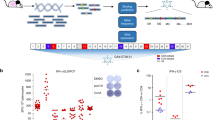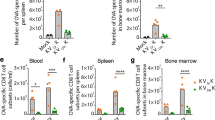Abstract
Mutations and aberrant expression of the p53 tumor suppressor protein are the most frequent molecular alterations in human malignancy. Peptides derived from the wild-type (wt) p53 protein and presented by major histocompatibility complex (MHC) molecules for T lymphocyte recognition are believed to serve as universal tumor-associated antigens for cancer immunotherapy. We studied the immunogeneicity of a recombinant replication-defective adenoviral vector encoding human full-length wt p53 (rAd/hup53) in human leukocyte antigen (HLA)-A2Kb-transgenic (Tg) mice and man. The generation of p53 epitope-specific cytotoxic T lymphocytes (CTLs) in p53-proficient and p53-deficient A2Kb-Tg mice was affected by self-tolerance and a selective inability of rAd/hup53 to induce p53.264-272 peptide-reactive effector cells. To extend this study into a pilot clinical trial, six advanced-stage cancer patients received sequential injections of rAd/hup53. The treatmenSt was well tolerated. To date, no evidence for objective tumor responses was observed. An amplification of humoral and cellular anti-adenoviral immune responses was demonstrated in all patients following rAd/hup53 vaccination. However, p53-reactive antibodies and HLA-A*0201 (A2.1)-restricted CTLs specific for wt p53 epitopes were not generated. Tailoring p53-based cancer immunotherapy thus requires the interference with p53-specific self-tolerance and the induction of the entire repertoire of p53-reactive T lymphocytes.
This is a preview of subscription content, access via your institution
Access options
Subscribe to this journal
Receive 12 print issues and online access
$259.00 per year
only $21.58 per issue
Buy this article
- Purchase on Springer Link
- Instant access to full article PDF
Prices may be subject to local taxes which are calculated during checkout





Similar content being viewed by others
References
Levine AJ . p53, the cellular gatekeeper for growth and division Cell 1997 88: 323–331
Theobald M et al. Targeting p53 as a general tumor antigen Proc Natl Acad Sci USA 1995 92: 11993–11997
Mayordomo JI et al. Therapy of murine tumors with p53 wild-type and mutant sequence peptide-based vaccines J Exp Med 1996 183: 1357–1365
Roth J et al. p53 as a target for cancer vaccines: recombinant canarypox virus vectors expressing p53 protect mice against lethal tumor challenge Proc Natl Acad Sci USA 1996 93: 4781–4786
Röpke M et al. Spontaneous human squamous cell carcinomas are killed by a human cytotoxic T lymphocyte clone recognizing a wild-type p53 derived peptide Proc Natl Acad Sci USA 1996 93: 14704–14707
Theobald M et al. Tolerance to p53 by A2.1-restricted cytotoxic T lymphocytes J Exp Med 1997 185: 833–841
Vierboom MP et al. Tumor eradication by wild-type p53-specific cytotoxic T lymphocytes J Exp Med 1997 186: 695–704
Yu Z et al. The use of transgenic mice to generate high affinity p53 specific cytolytic T cells J Surg Res 1997 69: 337–343
Gnjatic S et al. Accumulation of the p53 protein allows recognition by human CTL of a wild-type p53 epitope presented by breast carcinomas and melanomas J Immunol 1998 160: 328–333
Theobald M et al. The sequence alteration associated with a mutational hotspot in p53 protects cells from lysis by cytotoxic T lymphocytes specific for a flanking peptide epitope J Exp Med 1998 6: 1017–1028
Chikamatsu K et al. Generation of anti-p53 cytotoxic T lymphocytes from human peripheral blood using autologous dendritic cells Clin Cancer Res 1999 5: 1281–1288
Vierboom MP et al. High steady-state levels of p53 are not a prerequisite for tumor eradication by wild-type p53-specific cytotoxic T lymphocytes Cancer Res 2000 60: 5508–5513
Houbiers JG et al. In vitro induction of human cytotoxic T lymphocyte responses against peptides of mutant and wild-type p53 Eur J Immunol 1993 23: 2072–2077
Ishida T et al. Dendritic cells transduced with wild-type p53 gene elicit potent anti-tumor responses Clin Exp Immunol 1999 117: 244–251
Irwin MJ, Heath WR, Sherman LA . Species-restricted interactions between CD8 and the α3 domain of class I influence the magnitude of xenogeneic response J Exp Med 1989 170: 1091–1101
Vitiello A et al. Analysis of the HLA-restricted influenza-specific cytotoxic T lymphocyte response in transgenic mice carrying a chimeric human-mouse class I major histocompatibility complex J Exp Med 1991 173: 1007–1015
Schirle M et al. Identification of tumor-associated MHC class I ligands by a novel T cell-independent approach Eur J Immunol 2000 30: 2216–2225
Flomenberg P, Piaskowski V, Truitt RL, Casper JT . Characterization of human proliferative T cell responses to adenovirus J Infect Dis 1995 171: 1090–1096
Liu GY et al. Low avidity recognition of self-antigen by T cells permits escape from central tolerance Immunity 1995 3: 407–415
Nijman HW et al. Charcaterization of cytotoxic T lymphocyte epitopes of a self-protein, p53, and a non-self-protein, influenza matrix: Relationship between major histocompability complex peptide binding affinity and immune responsiveness to peptides J Immunother 1993 14: 121–126
Karjalainen K . High sensitivity, low affinity-paradox of T-cell receptor recognition Curr Opin Immunol 1994 6: 9–12
Alexander-Miller MA, Leggatt GR, Sarin A, Berzofsky JA . Role of antigen, CD8, and cytotoxic T lymphocyte (CTL) avidity in high dose antigen induction of apoptosis of effector CTL J Exp Med 1996 184: 485–492
Chen W, Antón LC, Bennink JR, Yewdell JW . Dissecting the multifactorial causes of immunodominance in class I restricted T cell responses to viruses Immunity 2000 12: 83–93
Molnar-Kimber KL et al. Impact of pre-existing and induced humoral and cellular immune responses in an adenovirus-based gene therapy phase I clinical trial for localized mesothelioma Hum Gene Ther 1998 9: 2121–2133
Harvey BG et al. Variability of human systemic humoral immune response to adenovirus gene transfer vectors administered to different organs J Virol 1999 73: 6729–6742
Kafri T et al. Cellular immune responses to adenoviral vector infected cells does not require de novo viral gene expression: implications for gene therapy Proc Natl Acad Sci USA 1998 95: 11377–11382
Soussi T . p53 antibodies in the sera of patients with various types of cancer: a review Cancer Res 2000 60: 1777–1788
Gahéry-Ségard H et al. Phase I trial of recombinant adenovirus gene transfer in lung cancer J Clin Invest 1997 100: 2218–2226
Molinier-Frenkel V et al. Longitudinal follow-up of cellular and humoral immunity induced by recombinant adenovirus-mediated gene therapy in cancer patients Hum Gene Ther 2000 11: 1911–1920
Yen N et al. Cellular and humoral immune response to adenovirus and p53 protein antigens in patients following intratumoral injection of an adenovirus vector expressing wild-type p53 (Ad-p53) Cancer Gene Ther 2000 7: 530–536
Van der Burg SH et al. Long lasting p53-specific T cell memory responses in the absence of anti-p53 antibodies in patients with resected primary colorectal cancer Eur J Immunol 2001 31: 146–155
Bennett SR et al. Help for cytotoxic-T-cell responses is mediated by CD40 signalling Nature 1998 393: 478–480
Schoenberger SP et al. T-cell help for cytotoxic T lymphocytes is mediated by CD40-CD40L interactions Nature 1998 393: 480–483
Ossendorp F et al. Specific T helper cell requirement for optimal induction of cytotoxic T lymphocytes against major histocompatibility complex class II negative tumors J Exp Med 1998 187: 693–702
Ossendorp F et al. Specific T helper cell requirement for optimal induction of cytotoxic T lymphocytes against major histocompatibility complex class II negative tumors Scholz C et al. Adenoviral transduction of tumor cells induces apoptosis in co-cultured T-lymphocytes (submitted for publication).
Nikitina EY et al. Dendritic cells transduced with full-length p53 generate antitumor cytotoxic T lymphocytes from peripheral blood of cancer patients Clin Cancer Res 2001 7: 127–135
Hoffmann TK et al. Generation of T cells specific for the wild-type sequence p53264-272 peptide in cancer patients: implications for immunoselection of epitope loss variants J Immunol 2000 165: 5938–5944
Daniel PT et al. Costimulatory signals through B7.1/CD28 prevent T cell apoptosis during target cell lysis J Immunol 1997 159: 3808–3815
Stanislawski T et al. Circumventing tolerance to a human MDM2-derived tumor antigen by TCR gene transfer Nat Immunol 2001 2: 962–970
Hoffmann TK et al. The ability of variant peptides to reverse the nonresponsiveness of T lymphocytes to the wild-type sequence p53264-272 epitope J Immunol 2002 168: 1338–1347
Morrison J et al. Identification of the nonamer peptide from influenza A matrix protein and the role of pockets of HLA-A2 in its recognition by cytotoxic T lymphocytes Eur J Immunol 1992 22: 903–907
Steven NM et al. Immediate early and early lytic cycle proteins are frequent targets of the Epstein-Barr virus-induced cytotoxic T cell response J Exp Med 1997 185: 1605–1618
Tsomides TJ, Walker BD, Eisen HN . An optimal viral peptide recognized by CD8+ T cells binds very tightly to the restricting class I major histocompatibility complex protein on intact cells but not to the purified class I protein Proc Natl Acad Sci USA 1991 88: 11276–11280
DeMars R et al. Mutations that impair a posttranscriptional step in expression of HLA-A and -B antigens Proc Natl Acad Sci USA 1985 82: 8183–8187
Dittmer D et al. Gain of function mutations in p53 Nat Genet 1993 4: 42–46
Sette A et al. The relationship between class I binding affinity and immunogenicity of potential cytotoxic T cell epitopes J Immunol 1994 153: 5586–5592
Drexler I et al. Modified vaccinia virus Ankara for delivery of human tyrosinase as melanoma-associated antigen: Induction of tyrosinase- and melanoma-specific human leukocyte antigen A*0201-restricted cytotoxic T cells in vitro and in vivo Cancer Res 1999 59: 4955–4963
Schuler M et al. A phase I study of adenovirus mediated gene transfer in patients with advanced non-small cell lung cancer Hum Gene Ther 1998 14: 2075–2082
Wills KN et al. Development and characterization of recombinant adenoviruses encoding human p53 for gene therapy of cancer Hum Gene Ther 1994 5: 1079–1088
Johnsson B, Lofas S, Lindquist G . Immobilization of proteins to a carboxymethyldextran modified gold surface for biospecific interaction analysis in surface plasmon resonance Anal Biochem 1991 198: 268–277
Ranieri E et al. Dendritic cells transduced with an adenovirus vector encoding Epstein-Barr virus latent membrane protein 2B: a new modality for vaccination J Virol 1999 73: 10416–10425
Wölfel C et al. Transporter (TAP)- and proteasome-independent presentation of a melanoma-associated tyrosinase epitope Int J Cancer 2000 88: 432–438
Miller AB, Hoogstraten B, Staquet M, Winkler A . Reporting results of cancer treatments Cancer 1981 47: 210–214
Acknowledgements
We thank the patients and their families for participating in this trial. We gratefully acknowledge the contributions of P Meinhardt, F Schmitz, H Huberts, JA Horowitz, B Hutchins and D Maneval. We thank M Jülch for flow cytometry analyses and C Lotz for critically reading the manuscript. These studies were supported by a grant from the Schering-Plough Research Institute, by the Tumor Vaccination Center at JGU (funded by the Deutsche Krebshilfe eV), and by grants from the Deutsche Forschungsgemeinschaft (SFB 432 A3) and the Stiftung Rheinland-Pfalz für Innovation to MT, and the MAIFOR program to JK and MT.
Author information
Authors and Affiliations
Rights and permissions
About this article
Cite this article
Kuball, J., Schuler, M., Antunes Ferreira, E. et al. Generating p53-specific cytotoxic T lymphocytes by recombinant adenoviral vector-based vaccination in mice, but not man. Gene Ther 9, 833–843 (2002). https://doi.org/10.1038/sj.gt.3301709
Received:
Accepted:
Published:
Issue Date:
DOI: https://doi.org/10.1038/sj.gt.3301709
Keywords
This article is cited by
-
Apoptosis Detection Methods in Diagnosis of Cancer and Their Potential Role in Treatment: Advantages and Disadvantages: a Review
Journal of Gastrointestinal Cancer (2021)
-
Apoptosis in cancer: from pathogenesis to treatment
Journal of Experimental & Clinical Cancer Research (2011)
-
An MVA vaccine overcomes tolerance to human p53 in mice and humans
Cancer Immunology, Immunotherapy (2007)



